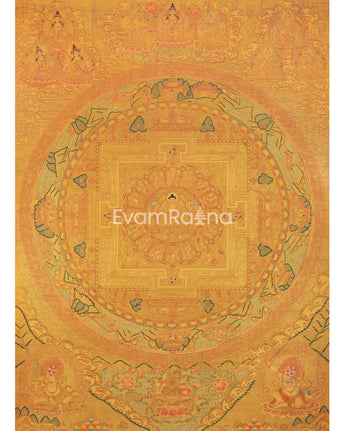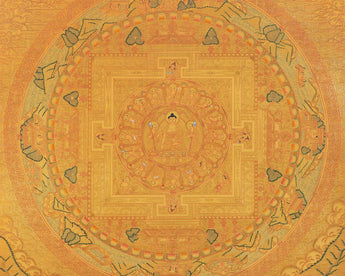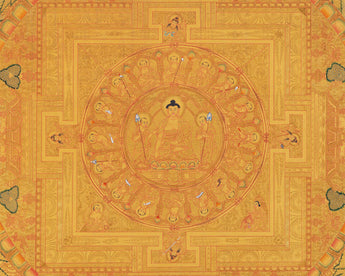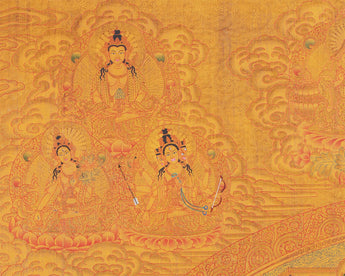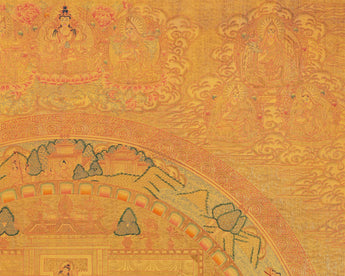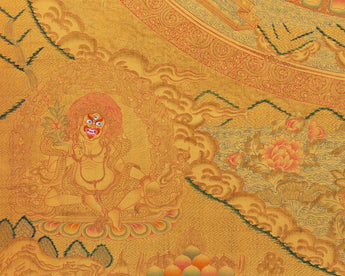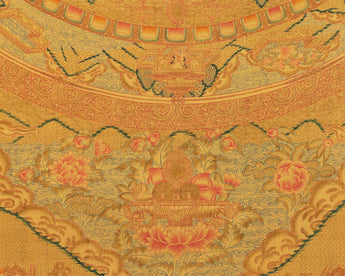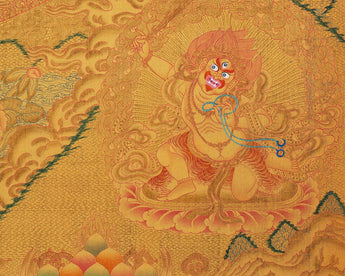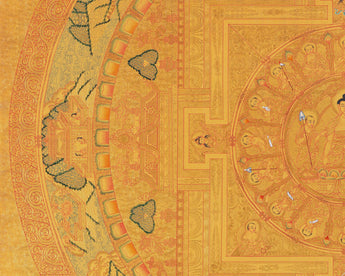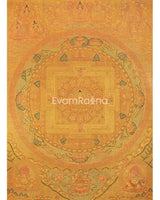
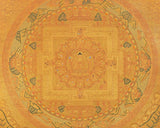
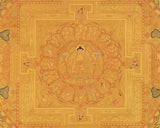
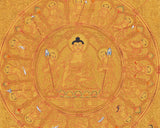
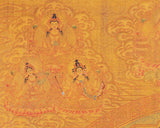
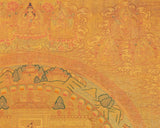
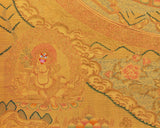
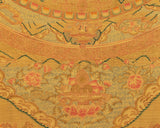
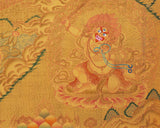
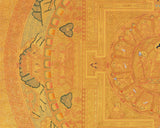
Shakyamuni Buddha Mandala Thangka with Pure 24k Golden Embellishment | Wall Hanging Yoga Meditation Canvas Art | Spiritual Gift Idea

100% AUTHENTIC

HANDPAINTED

FREE SHIPPING
Buddha Mandala Thangka
Shakyamuni Buddha Mandala painted on both sides.Shakyamuni Buddha was born in 527 B.C . He was the son of King Sudhodana and Queen Maya Devi . Shakyamuni Buddha was known before attaining enlightenment as Siddhartha or Gautama .
Buddha Shakyamuni is mostly seen at the centre seated on a thousand petal lotus throne .The lotus plant symbolizes his purity and serene nature .He is portrayed meditating in the earth—touching gesture holding an alms bowl with his left hand on top of his lap. He is yellow in color and wears a robe .
When Shakyamuni Buddha was on the verge of Perfect enlightenment ,he had to face both internal and external Maras (Temptations ).It is believed that Devaputra Mara questioned him on the validity of his attainment of Enlightenment and his perfection .At that time, his only witness was mother earth. Buddha Shakyamuni asked mother earth to bear witness to his attainment of paramita or perfection. To indicate this, he touched the earth with his right hand as witness to his perfection.This form of Buddha depicts this incident.
About Mandala
Mandala literally means a circle . The tibetan word for madala is Kyilkhor , which means “centre and surrounding environment .” In simple terms it is a circle used as a visual aid for concentration and introversive meditation . Meditating using a mandala leads to the attainment of insights and it helps to increase one’s level of concentration . It also helps to activate forces within oneself which culminates into “Siddhi ” or super – natural forces . The mandala is the graphic representation of this process . It is not only theoretical but practical as an operational scheme involving a clear plan for practical realization of the process within oneself . It thus becomes an instrument ( Yantra ) . It is believed that by just looking at a mandala one’s soul is spiritually purified. Thus , a mandala represents the palace of purity a magic circle cleansed of spiritual obstacles and impurities . The square of the sacred palace is enclosed in multiple circles of flame, vajra and lotus . These three circles forming the outer rims of the mandala symbolizes enlightenment , which the meditating person must gain , before he or she can enter the illuminated palace . The mandala then consists of the inner square where the deity of the mandala resides .
The outer most circle or the fire circle also known as the Fire of wisdom
Consists of the purifying fire . The diamond circle or the vajra circle expresses strength and fearlessness and finally the lotus circle expresses the open state of devotion , that is necessary to enter the palace . These three elements denotes the state of mind that the follower or the person meditating must possess before practicing the dharma .
The name of the mandala is determined according to the deity residing in the center of the sacred palace.
------------------------------------------------------------------
Size: 20"/51 cm (width) x 28"/71 cm (height)
Materials: Cotton Canvas, Acrylic Colors, Genuine 24K Gold
------------------------------------------------------------------
THIS THANGKA IS HAND-PAINTED IN THE TRADITIONAL STYLE AND THE QUALITY IS HIGH
How to Take Care of Your Thangka?
- Hang your thangka in a traditional silk brocade.
- Regularly inspect your thangka; examine the borders and all attachments.
- Keep thangkas covered when they are on display but not in use.
- Rotate thangkas between display and storage two to four times a year to reduce exposure to light. Keep them away from sunlight and humidity.
- Do not apply liquids or other materials to the surface of the thangka.


